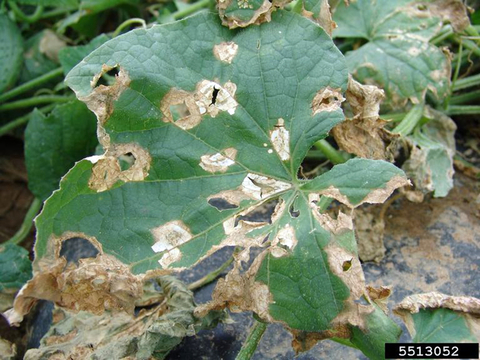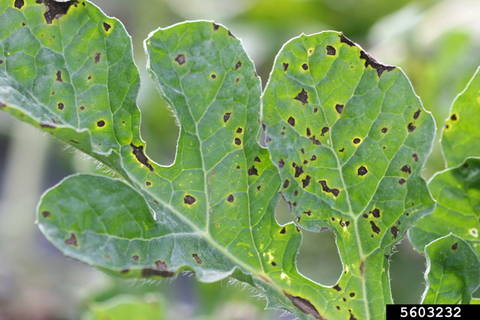Quick facts
- Leaf spots of varying shape and color form on different cucurbits.
- Fruit infections are sunken black spots 1/4 -1/2 inch across and 1/4 inch deep.
- The anthracnose fungus can survive in infected plant debris and seed.
- The disease develops in warm, moist environmental conditions.
- Rotate vegetables so three years go by before planting any member of the squash family in the same location.
- Do not work in wet fields or gardens.
How to tell anthracnose apart from other cucurbit issues
- Anthracnose can infect all above-ground plant parts. Symptoms vary depending on which cucurbit it infects.
- Irregular brown leaf spots form on squash, melon and cucumber. The center of the leaf spot may drop out resulting in a ragged appearance. This is most common on cucumbers.
- Cucumber leaf spots often have a yellow halo.
- Watermelon leaf spots are smaller and dark brown to black.
- Sunken elongated stem infections can occur on cucumber and melon but are not common on other cucurbits. Infections on melon often exude a reddish gum.
- Fruit infections are sunken black spots 1/4 -1/2 inch across and 1/4 inch deep. Spots may have fluffy white cotton-like mycelia and sticky salmon-colored spores during wet weather.
Biology
- The fungus Colletotrichum orbiculare causes anthracnose. This pathogen can attack all cucurbits, but the most severe disease is on cucumbers, muskmelons and watermelons.
- The anthracnose fungus can survive in infected plant debris and seed.
- Spores form on infected leaves and fruit. These easily spread by splashing rain, irrigation, on hands and tools.
- The disease develops in warm, moist environmental conditions.
- Anthracnose first appears mid to late season after the canopy closes.
- During wet summers, the disease can be quite severe.
How to manage anthracnose in the home garden
- Some resistant varieties of cucumber are available.
- Purchase clean seed from a reputable source. Do not save seed from infected plants.
- Rotate vegetables so three years go by before planting any member of the squash family in the same location.
- Avoid getting leaves wet with water by using drip irrigation, a soaker hose, or careful watering technique.
- Do not work in plants when wet.
- Remove and destroy infected vines at the end of the season in small gardens.
- After working in an infected area, clean and sanitize any tools you used, and clean dirt off of your shoes.
How to manage anthracnose on farms
|
Some resistant varieties of cucumber are available.
- Purchase clean seed from a reputable source. Do not save seed from infected plants.
- Rotate vegetables so three years go by before planting any member of the squash family in the same location.
- Use drip irrigation instead of overhead sprinklers if possible.
- Do not work in plants when wet.
- Remove and destroy infected vines at the end of the season in small gardens.
- In large fields, till under crop residue at the end of the season.
- After working in an infected area, clean and sanitize any tools you used, and clean dirt off of your shoes and tractor wheels.
- Several fungicides are available for use against anthracnose. They may not provide adequate control if there is not good coverage of fruit and leaves.
- Commercial growers should refer to the Midwest Vegetable Production Guide for specific fungicide recommendations.
CAUTION: Mention of a pesticide or use of a pesticide label is for educational purposes only. Always follow the pesticide label directions attached to the pesticide container you are using. Be sure that the area you wish to treat is listed on the label of the pesticide you intend to use. Remember, the label is the law.
Reviewed in 2022





